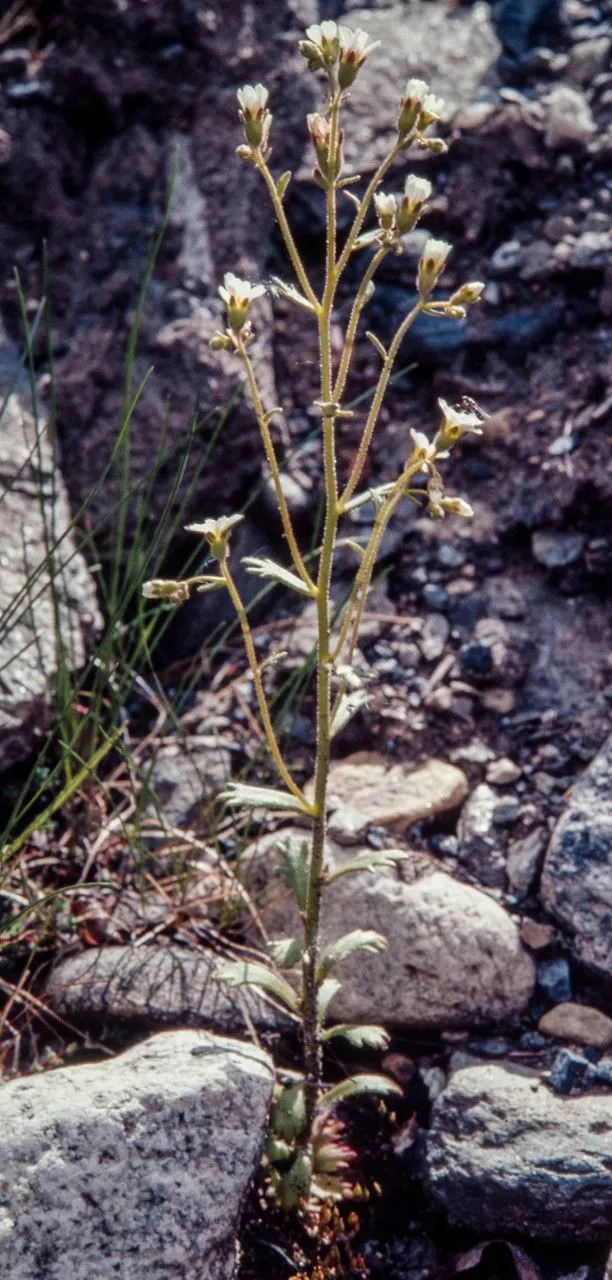
Author: L.
Bibliography: Sp. Pl.: 405 (1753)
Year: 1753
Status: accepted
Rank: species
Genus: Saxifraga
Vegetable: False
Observations: Subarctic America to NW. & WC. U.S.A., Europe to Caucasus
The Wedgeleaf saxifrage, known scientifically as Saxifraga adscendens, is a fascinating and hardy member of the family Saxifragaceae. First described in the seminal work “Species Plantarum” in 1753 by the renowned botanist Carl Linnaeus, this plant has captivated botanists and nature enthusiasts alike for centuries.
This species is characterized by its rosette of wedge-shaped basal leaves, from which it derives its common name. The leaves are typically fleshy and adapt to a variety of harsh climatic conditions, indicative of its wide range of habitats. The plant produces delicate, star-shaped white flowers that often exhibit a subtle charm against the rugged terrains it inhabits. These flowers bloom in the spring and summer, adding a touch of beauty to the environs.
The Wedgeleaf saxifrage boasts a broad geographical distribution. It is commonly found from the subarctic regions of America, stretching across the Northwestern and Western regions of the United States. Its presence extends across the Atlantic into Europe and reaches as far as the Caucasus. This broad distribution is a testament to its adaptability and resilience, thriving in diverse climates ranging from the icy Arctic tundras to more temperate mountainous areas.
Ecologically, Saxifraga adscendens plays a crucial role in its habitat, often thriving in rocky, alpine environments where few other plants can survive. Its growth can help stabilize soil and rock, preventing erosion and contributing to the ecosystem’s biodiversity. Additionally, it provides a nectar source for various pollinators such as bees and butterflies, which play a vital role in maintaining the health and proliferation of plant species in these regions.
Despite its hardy nature, the Wedgeleaf saxifrage is a plant that benefits from conservation efforts, especially in areas where its natural habitats are threatened by climate change and human activities. Preservation of this species ensures the maintenance of the ecological balance in the environments it inhabits.
For gardeners and plant enthusiasts, cultivating Saxifraga adscendens can be a rewarding endeavor, provided the right growing conditions are met. It prefers well-drained soil and can tolerate partial shade to full sunlight. Its resilience to cold makes it an excellent choice for rock gardens or alpine-themed landscapes.
In summary, the Wedgeleaf saxifrage is not only a plant of great historical botanical interest but also one of significant ecological importance. Its ability to thrive in challenging conditions, along with its delicate floral beauty, makes it a remarkable specimen for study and admiration.
Swe: kalliorikko, klippbräcka
Fin: kalliorikko
Nno: skoresildre
Nob: skåresildre
Eng: wedgeleaf saxifrage, ascending saxifrage, rock saxifrage, wedge-leaved saxifrage
Sme: hildonarti
Fra: saxifrage ascendante
En: Wedgeleaf saxifrage, Wedge-Leaf Saxifrage, ROCK SAXIFRAGE, Ascending saxifrage, Wedge-leaved saxifrage, Biennial Saxifrage
Fi: Kalliorikko
Fr: Saxifrage ascendante, Saxifrage à tige dressée
De: Aufsteigender Steinbrech
It: Sassifraga ascendete, Sassifraga ascendente
Se: Hildonarti
Nb: Skåresildre
Nn: Skoresildre
Sv: Kalliorikko, Klippbräcka
Taken Jan 1, 1900 by EOL − Encyclopedia of Life (cc-by-nc)
Taken Jul 15, 2009 by Photoflora – Jean-Luc TASSET (©)
Taken Jan 1, 1900 by EOL − Encyclopedia of Life (cc-by-nc)
Taken Jan 1, 1900 by EOL − Encyclopedia of Life (cc-by-nc)
Taken Jul 11, 1997 by Andrew Gagg (cc-by-sa)
Taken Jul 15, 2008 by Photoflora – Benoit BOCK (©)
Taken Jul 15, 2009 by Photoflora – Jean-Luc TASSET (©)
Taken Jul 15, 2009 by Photoflora – Jean-Luc TASSET (©)
Taken Jul 15, 2016 by Photoflora – Jean-Luc TASSET (©)
Taken Jul 11, 1997 by Andrew Gagg (cc-by-sa)
Taken May 24, 2020 by Emanuele Santarelli (cc-by-sa)
Taken May 31, 2022 by Roosa Hautala (cc-by-sa)
Taken Jul 16, 2015 by Tela Botanica − Henri SCORDIA (cc-by-sa)
Taken Jul 16, 2015 by Tela Botanica − Henri SCORDIA (cc-by-sa)
Taken Jul 16, 2015 by Tela Botanica − Henri SCORDIA (cc-by-sa)
Taken Jul 15, 2008 by Photoflora – Benoit BOCK (©)
Taken Jul 15, 2008 by Photoflora – Benoit BOCK (©)
Taken Jul 15, 2008 by Photoflora – Benoit BOCK (©)
Taken Jan 1, 1970 by Photoflora – L’Abbé COSTE (©)
Taken Jul 15, 2008 by Photoflora – Benoit BOCK (©)
Taken Jul 15, 2008 by Photoflora – Benoit BOCK (©)
Growth habit>: Forb/herb
Ph maximum: 7.0
Ph minimum: 6.5
Light: 8
Atmospheric humidity: 5
Soil nutriments: 3
Family: Myrtaceae Author: (F.Muell.) K.D.Hill & L.A.S.Johnson Bibliography: Telopea 6: 402 (1995) Year: 1995 Status:…
Family: Rubiaceae Author: Pierre ex A.Froehner Bibliography: Notizbl. Bot. Gart. Berlin-Dahlem 1: 237 (1897) Year:…
Family: Sapindaceae Author: Koidz. Bibliography: J. Coll. Sci. Imp. Univ. Tokyo 32(1): 38 (1911) Year:…
Family: Asteraceae Author: A.Gray Bibliography: Pacif. Railr. Rep.: 107 (1857) Year: 1857 Status: accepted Rank:…
Family: Fabaceae Author: Medik. Bibliography: Vorles. Churpfälz. Phys.-Ökon. Ges. 2: 398 (1787) Year: 1787 Status:…
Family: Aspleniaceae Author: (Cav.) Alston Bibliography: Bull. Misc. Inform. Kew 1932: 309 (1932) Year: 1932…